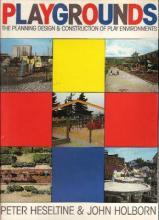
Peter Heseltine and John Holborn, coauthors of Playgrounds: The Planning, Design and Construction of Play Environments, re-examine how children relate to their environment and focus on the developmental needs of children as they learn and grow through play. Believing that play is a basic need for the development of children and that children are our society's “finest natural resource,” they seek in Playgrounds to shift the focus of playground design from adult concerns to child-centered play value.1
After defining play to be “a process by which children learn and come to terms with (their) social and physical environments – not the end product of what they do,” Heseltine and Holborn further distinguish between play and recreation. Play involves child learning, development, and growth while recreation is a reviving of spirits through relaxation and enjoyment. They state that this confusion between “the means and the end is one of the major impediments in understand and providing for play... Mere activity is not play.”2
For background, Heseltine and Holborn briefly trace the theories of play from Plato and Aristotle through Jean-Jacques Rousseau and Friedrich Froebel and up to Sigmund Freud and Jean Piaget. Their primary focus is on Piaget's definition of play that involves the process of assimilating and accommodating an environment, a process that develops a child's intellect. Later in Playgrounds they correlate assimilation and accommodation with the physical and behavioral environments, natural forces, and creativity features of playgrounds. Some of these developmental playground features include natural plants and small animal life, textures and colors of surfaces and equipment, sand and water play, variety of play structures and loose parts play, and child's play movements and playworker's involvement.3
The importance of learning through play, according to Heseltine and Holborn, is that “the child assimilates the concepts, accommodating them at his or her own pace and in his or her own way. The need to experience and experiment is all-important and the lesson will be more fully learnt.”4 They also point out the significance of natural play environments, motor skill development, creative play through “loose” materials, and the understanding of “self in relation to the environment and to others.”5
To define what is quality play, Playgrounds outlines factors such as the duration of playing time, the ability to change the play environment, the relevance of activities to a child's needs, increasing levels of challenge, and the opportunity for cooperative or group play.6 They also discuss the history of children's needs in society and the current roles of children in homes, schools, work places, and recreation facilities. They conclude that as a society children are increasingly being separated from adults and there are fewer opportunities for them to play creatively.7
Written to largely a United Kingdom audience in 1987, Playgrounds offers solutions to the planners, architects and designers, manufacturers, educationalists, academics, politicians, and parents who influence the creation of playgrounds. Through copious pictures giving “good and bad” examples of playgrounds, Heseltine and Holborn discuss in depth the location and quality of play spaces, the planning for and standards of playgrounds, the developing of different kinds of playgrounds, and details of playground designs and equipment.
Some of the playground elements highlighted include the unusual elements of cable runs, graffiti boards, surface markings, and jumping pits as well as the more common slides, swings, climbing equipment, and sand and water play. Formal and informal playgrounds, natural and maintained play spaces, and hard surfaced “kickabout” and grassy play areas are all explored for their various play values.
The book also addresses the issues of access, layout problems, and accidents. The importance of these details is underscored by their statement that “Layout problems would appear to account for around 35 per cent of accidents. The reasons for this include simple positioning errors, providing equipment which is unsuitable for the site or age of users, getting sight-lines wrong so the children's attention is diverted, and installing the wrong surfacing.”8
When planning play spaces, Heseltine and Holborn note two detrimental trends: to over plan every available space and to opt for the quick and easy “solutions” such as colorful equipment that sidesteps the children's development needs.9 Two examples of these child developmental needs are the need for formal play spaces close to their homes for pre-school children and informal play areas which can be manipulated and altered for older aged children.10 One result of these poor planning trends is the creation of “ghetto playground(s) covered in unused metal equipment” instead of the more involved “creation” playgrounds that require supervision, and thus an ongoing commitment of time and expense.11
In summary they conclude: “Perhaps the most crucial aspect of design is knowing when and when not to intervene. It is the role of the designer to provide the opportunity for children to create their own play, hence the importance of not over-designing 'found' or informal space – some of the worst playgrounds are perpetrated by architects in places designated by planners after destroying the natural environment. Because he or she can design a playground does not mean it must be done.”12
- 1. Heseltine, Peter and John Holborn. Playgrounds: The Planning, Design and Construction of Play Environments. New York: Nichols Publishing Company, 1987. p. 12.
- 2. Op.cit., Playgrounds. p. 11.
- 3. Op.cit., Playgrounds. p. 114.
- 4. Op.cit., Playgrounds. p. 17.
- 5. Op.cit., Playgrounds. p. 18.
- 6. Op.cit., Playgrounds. pp.19-20.
- 7. Op.cit., Playgrounds. p. 21.
- 8. Op.cit., Playgrounds. pp. 114-115.
- 9. Op.cit., Playgrounds. pp. 24-26.
- 10. Op.cit., Playgrounds. p. 29.
- 11. Op.cit., Playgrounds. p. 54.
- 12. Op.cit., Playgrounds. p. 54.

